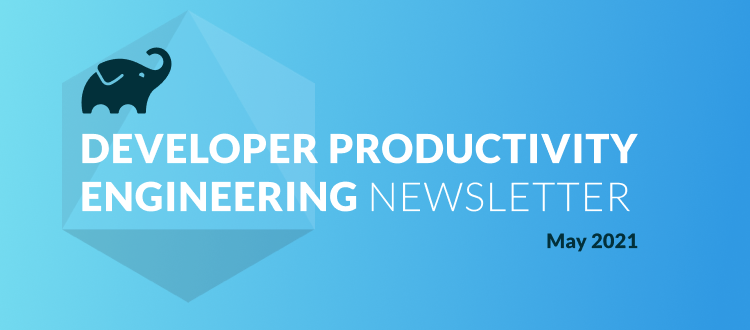
EXPERT TAKES
Season 1 of DevProdEng Showdown is well underway with three episodes that have been viewed live or on-demand by over 6,000 people since our pilot episode aired in January. If you are not already familiar with this unique event, you can learn more and register here for Episode 4, which takes place Wednesday, May 26, 2021 (10am SF, 1pm NY, 6pm London, 7pm Berlin). The topic is “Android Architecture and Developer Productivity Engineering at Scale.”
In our most recent Blog post, we shared a great example of some expert takes from the last DevProdEng Showdown. One question posed to the panelists was ‘how would you explain to upper management why they should spend more resources on developer productivity?’ Read the Blog to hear what the experts had to say and whose answer the audience liked best.

INDUSTRY NEWS
If you are thinking about investing in a DPE initiative, there is a lot of compelling industry data to suggest that the investment is warranted and you are not alone in your productivity pains. According to a recently published report entitled: “In Search of Lost Time: Developer Productivity in the Cloud Native Era” developers spend, on average, more than 15 hours every week on tasks outside of writing application code. In the US alone, this time spent could be costing companies up to $61 billion per year.
Here are some notable data points from the report:
- 70% of respondents say that the time they waste on unproductive tasks could be put to more strategic use like developing new products (49%) and improving the speed and delivery of existing products and services (46%).
- Developers spend ~3 hours per week (1) waiting for pipelines (e.g. CI) to run; (2) waiting for builds and tests to complete outside of CI; (3) monitoring and debugging pipelines; and (4) writing and monitoring internal tools.
- Not surprisingly then the four time sinks mentioned above represented the four “most frustrating daily tasks” experienced by respondents, 76%, 74%, 71%, and 66% respectively.
If you’re interested in getting more ideas about how to build a business case for DPE, this post from the DPE Blog would be a good place to start.

PRODUCT NEWS
The new major release of the Gradle Build Tool is out! This release enables file system watching by default to make your incremental builds faster, expands support for building projects with Java 16, and adds support for building on Macs using Apple Silicon processors such as M1. This release also introduces a feature preview for centralized dependency versions. See also the “What’s new in Gradle 7” page highlighting the most important changes since Gradle 6.0.

SUCCESS STORY
In a recent guest blog post, Roger Taracha, senior Android engineer at Premise Data, shares his company's successful experience using build-cache node replication to serve their distributed teams across the globe. Roger begins with a conceptual recap of the Gradle Build Cache, its benefits, and general installation/configuration considerations. He then outlines the key benefits of node replication and the setup and configuration process (including connecting to Gradle Enterprise). Roger closes by sharing the inner workings of the Gradle build script solution that optimizes replicated node selection for local developer performance.

IDEAS & INSIGHTS
As Coinbase scaled from a single service to many, they invested in tools to give them the confidence they needed to rapidly ship new services to production. Like other growing technology companies, they had been scaling their once monolithic infrastructure through new microservices with the aim to encapsulate well defined tasks, buy-down technical debt, and help Coinbase move fast. As the company has gone down this path, the DevOps team worked to maintain high levels of developer productivity. Coinbase used data to guide their work and now shares their results and ways to think about developer productivity in this recent Blog post.
|
